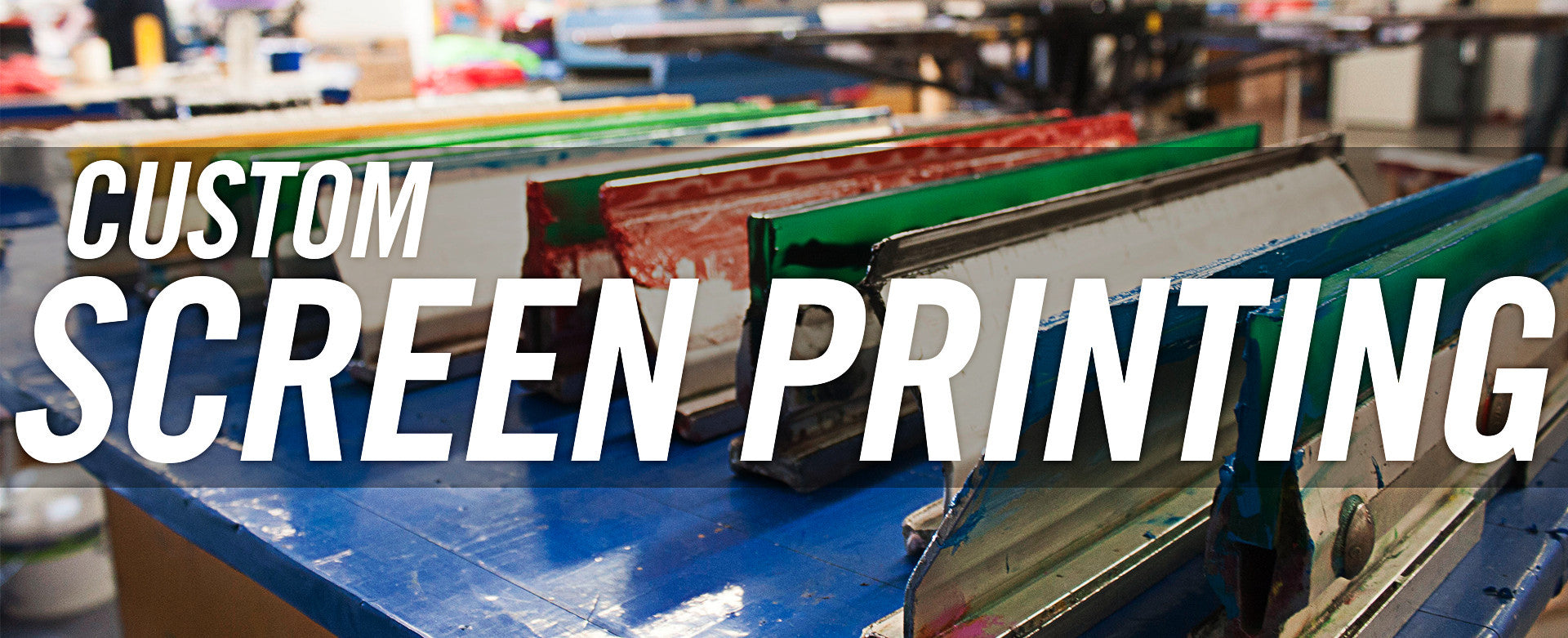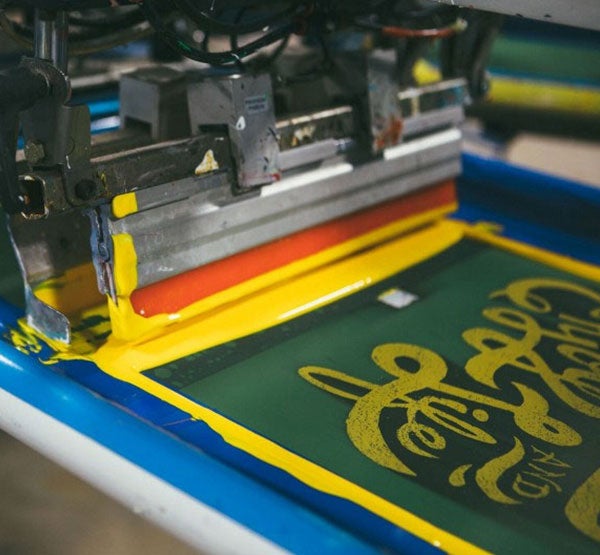Best Local T-Shirt Printing for Personalized Apparel
Wiki Article
Screen Printing Uncovered: Every Little Thing You Need to Understand About Tee Shirt and Garment Printing Strategies
Display printing is an interesting approach that integrates art with method, providing countless opportunities for imagination. All set to discover the vital components that make screen printing an art kind?
The Basics of Screen Printing: How It Works
When you plunge right into screen printing, you'll uncover it's both an art and a scientific research. At its core, screen printing entails producing a stencil, or display, that permits ink to pass through only in particular areas.Next, you'll blend your inks and prepare your printing surface. Setting the display over the textile, then utilize a squeegee to push ink through the display onto the garment. This process requires precision, as you desire clear, vivid prints. After printing, you'll heal the ink with warmth, guaranteeing it follows the textile and lasts through laundries. Each action is vital, and mastering them will raise your screen printing skills, transforming easy garments right into one-of-a-kind, meaningful pieces.
Kinds Of Screen Printing Strategies
Once you realize the fundamentals of screen printing, it's time to explore the numerous strategies that can boost your layouts. One prominent approach is standard screen printing, where ink is pushed through a stenciled screen.If you're going for fine information, consider discharge printing. This strategy gets rid of color from the textile, leaving a soft, vintage look. One more choice is plastisol printing, recognized for its durability and dazzling shades, making it a favorite for numerous brand names. Experiment with halftone printing to develop slope results and intricate layouts. Each strategy has its special appeal, so don't be reluctant to try them bent on locate what fits your style best!
Essential Equipment for Display Printing
To accomplish magnificent outcomes in display printing, having the ideal devices is basic. You'll need a sturdy display printing structure, which holds the mesh that transfers your design onto the garment. Next, spend in premium mops; these are essential for using ink equally throughout the display.Selecting the Right Inks and Products
When selecting inks and materials for display printing, you need to consider the kind of ink that functions ideal for your job. Think concerning fabric compatibility to assure your layouts look last and great long. Also, discover environment-friendly ink choices to make your printing process extra lasting.Sorts Of Screen Inks
Picking the best screen ink is necessary for achieving vivid, long lasting prints that meet your job's needs. There are several types of screen inks to check out. Plastisol ink is preferred for its flexibility and ease of use, giving superb shade opacity on dark textiles. Water-based ink, on the various other hand, supplies a softer feel and is eco-friendly, making it optimal for those aiming to minimize their environmental influence. Release inks remove dye from the textile, resulting in a soft, classic appearance however call for details handling. Ultimately, specialty inks, such as metal or glow-in-the-dark, can include unique impacts to your layouts. Evaluate your project requirements and choose the ink that lines up best with your desired result.
Textile Compatibility Factors To Consider
Understanding material compatibility is important for accomplishing top notch display prints, specifically given that different products react distinctly to different inks. When selecting inks, think about the material type-- cotton, polyester, or blends. For cotton, water-based inks function well, offering softness and breathability. Polyester, on the other hand, frequently calls for plastisol inks for better attachment and vibrant shades. You could need to use a mix of both kinds if you're printing on blends. Constantly test your inks on sample textile to assure they stick effectively and maintain shade stability. Additionally, keep in mind that fabric weight and appearance can affect the last outcome, so choosing the best ink and product combination is vital for your project's success.Eco-Friendly Ink Options
Environmentally friendly inks are coming to be a prominent selection for display printers who wish to reduce their ecological effect while maintaining quality. When choosing inks, think about water-based inks, which are much less damaging and easier to tidy up contrasted to conventional solvents. These inks bond well with fabrics, providing dynamic results without harmful chemicals. You may additionally discover eco-solvent inks that use less unpredictable natural compounds (VOCs), making them a much safer option for both your wellness and the world.Furthermore, look for inks made from renewable energies, such as soy or vegetable-based alternatives. By picking the best inks and products, you'll not only produce spectacular designs however additionally add to an extra sustainable printing process. Make the switch, and your prints will certainly show your dedication to the atmosphere!
Preparing Your Layout for Display Printing

Submit Layout Requirements
To ensure your design looks sharp and dynamic on fabric, you'll need to pay very close attention to submit format demands for screen printing. Begin with vector files like AI or EPS, as they can be scaled without shedding quality. If you utilize raster pictures, go with high-resolution data, such as TIFF or PNG, ideally at 300 DPI. Stay clear of utilizing JPEGs, as they can shed clearness when resized. Likewise, see to it your layout has a transparent background to prevent unwanted white edges on your prints. Ultimately, maintain color settings in mind; CMYK is conventional for display printing, so transform your RGB creates appropriately. By adhering to these guidelines, you'll establish your artwork up for a successful print.Shade Separation Strategies
Color separation is an important action in preparing your design for display printing, and mastering it can significantly enhance your print quality. You'll require to break your layout right into specific colors, as each shade needs a separate screen during printing. Beginning by identifying all the shades in your style and develop layers for each one. You can utilize software like Adobe Photoshop or Illustrator to separate and different shades successfully. Be specific to conserve each layer as a different data, usually in a format like TIFF or PSD. This accuracy not only guarantees exact shade representation but likewise streamlines the printing process. By taking note of color splitting up, you'll achieve vibrant and professional lead to your screen-printed garments.Resolution and Size
Achieving the most effective cause display printing begins with guaranteeing your layout has the right resolution and size. Preferably, your artwork needs to be at least 300 DPI (dots per inch) for sharp, clear prints. Your last item may look pixelated and less than garment printing professional. if you utilize reduced resolution.When it involves size, consider the dimensions of your print area. Design your art work to match the last print size, ideally creating it in the actual measurements you'll be publishing. By doing this, you'll stay clear of any unanticipated scaling concerns.
Always inspect your design in both vector and raster layouts. Vector graphics can be scaled without shedding quality, making them excellent for display printing. Preparing appropriately will ensure your layout looks fantastic on every garment!
Step-by-Step Display Printing Process
Screen printing is a vibrant process that permits you to produce vibrant designs on various surfaces. To obtain started, you'll require a screen, emulsion, and your selected ink. Initially, prepare your display by cleansing it completely. Next off, use the emulsion equally and let it completely dry in a dark area. Once completely dry, subject your screen to light with your style positioned on it, which will certainly set the solution where the light hits, developing a pattern - screen printing kit.Pour ink onto the display and use a squeegee to press the ink through the pattern onto the textile. Raise the screen very carefully and allow the print dry. You have actually effectively display printed your layout.
Tips for Effective Display Printing Projects
While you're diving into your screen printing projects, remember that preparation is vital to success. Beginning by collecting all your materials-- inks, screens, mops, and garments. A tidy office helps protect against unwanted errors, so clean up before you begin.Following, confirm your artwork is high-resolution and correctly sized for your garment. Check your display for appropriate direct exposure and tidy it extensively to stay clear of spots. When blending your inks, comply with the producer's standards to attain the best uniformity.
Throughout printing, use also pressure with your squeegee for regular outcomes. Do not rush; take your time to confirm each print fulfills your criteria. After printing, let your garments dry completely prior to dealing with or packaging them.
Lastly, constantly keep an example of your job for future recommendation. In this manner, you can assess your development and boost your techniques with time. Satisfied printing!

Often Asked Questions
Just how Long Does It Require To Establish up a Display Printing Work?
Establishing a screen printing task generally takes around half an hour to an hour. You'll prepare the displays, mix inks, and change journalism. The moment varies based upon complexity and experience, so stay arranged!Can I Publish on Different Fabric Types Making Use Of the Very Same Strategy?
Yes, you can print on different textile kinds using the same strategy, however you'll need to adjust your settings and inks. Some fabrics soak up ink differently, so trying out warranties the very best results for each product.What Prevail Errors to Stay Clear Of in Display Printing?
When screen printing, prevent common blunders like utilizing the wrong ink, overlooking correct direct exposure times, or skipping pre-press checks. Constantly check your setup and keep clean displays to assure top quality results each time.Just How Can I Correctly Tidy and Preserve My Display Printing Devices?
To properly tidy and keep your screen printing tools, you should frequently clean screens with ideal solvents, check mops for wear, and guarantee all tools are kept dust-free and dry. Uniformity boosts and avoids pricey repairs efficiency.Is Screen Printing Eco-friendly Compared to Various Other Approaches?
Screen printing can be much more eco-friendly than other techniques, especially if you use water-based inks and eco-conscious products. By picking sustainable materials and techniques, you reduce waste and reduce your influence on the planet.Screen Printing Uncovered: Every Little Thing You Required to Know About T-Shirt and Garment Printing Strategies
At its core, display printing entails creating a stencil, or screen, that permits ink to pass with only in certain locations. Placement the screen over the textile, then use a squeegee to push ink with the screen onto the garment. One prominent approach is conventional screen printing, where ink is pushed with a stenciled screen.When selecting inks and materials for display printing, you require to take right into account the kind of ink that functions best for your project.
Report this wiki page